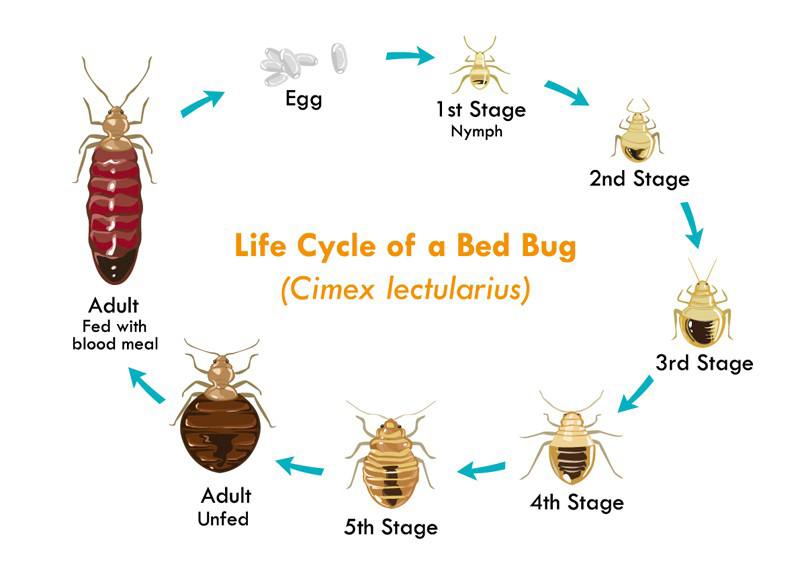FACTS ABOUT BED BUGS
Bed bugs are nocturnal wingless insects that are roughly oval in shape and 5 to 6 mm long when fully grown (reddish-brown in colour). They respond to the warmth and carbon dioxide emitted by the host and have mouthparts for piercing skin and sucking blood on humans (their preferred hosts). However, they are known to survive for several months without a feed. Bed bugs are highly productive in which after mating, each female lays 2-3 eggs a day throughout her lifespan. Bed bugs are great travellers of the world and are readily transported via luggage, used furniture, clothing & beddings. Tell-tale signs of bed bug infestations are ‘blood spotting’ on bed sheets and on walls and ‘black staining’ (caused by excrements) around seams/edges of mattresses.
LIFE CYCLE
The different stages of the bed bug life cycle are shown above as the bed bugs develop from freshly hatched nymphs to mature adults.
Eggs
Every bed bug’s life starts as an egg. These eggs are the tiny and about the size of a pin head or grain of salt. They are milky white and are found in secure hiding spots like under the seams of mattresses and in the cracks of the bed frame. In a female bed bug’s lifetime, she will lay between 500 eggs and 1000 eggs if she lives to a bed bug’s average life expectancy. It will take these eggs between 7 – 15 days to hatch depending on the environment and they will produce the 1 st stage of nymphs.
Nymphs
The different stages of nymphs are the 2 nd – 6 th stage of the bed bugs life cycle. After a bed bug hatches, it will be in the first nymph stage and measure about 1.5 mm. At first, they will be almost completely transparent, but they will grow in size and develop a reddish-brown color over the next 4 molting cycles. Each week, a nymph will feed which will allow it to grow and molt its exoskeleton as it grows.
- 1 st stage nymph is 1.5 mm
- 2 nd stage nymph is 2 mm
- 3 rd stage nymph is 2.5 mm
- 4 th stage nymph is 3 mm
- 5 th stage nymph is 4.5 mm
Adults
Upon reaching adulthood after the final nymph stage, bed bugs will continue to grow a little more before reaching their full size at 7- 8 mm. They will feed more frequently and regularly in order to maintain egg production now that they are able to produce eggs. The average lifespan of adult bed bugs can be between 4 – 18 months depending on available resources and environmental conditions.
TREATMENT
A detailed and thorough inspection would be conducted to all the beds & bed frame to determine the harbourage area and eggs of bed bugs. 1STEP® Bed Bug Powder (chemical-free pesticides) would be puffed to areas where residual spraying is not feasible.
TIPS:
PERSONAL HYGIENE AND GOOD HOUSEKEEPING ARE ESSENTIAL TO PREVENT BED BUG INFESTATIONS
- The rooms have numerous harbourage areas for bedbugs to hide in the day and feed in the night. Possible harbourage areas are gaps on the bed frame as well as the mattresses.
- Often, a bed bug bite is often mistaken as a mosquito bite by most people. Hence, when the activity of the pests is visible, the infestations would have reached moderate levels and treatments would then be very tedious and expensive.

